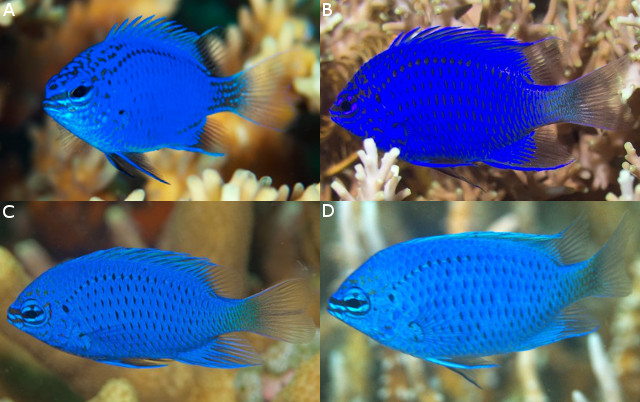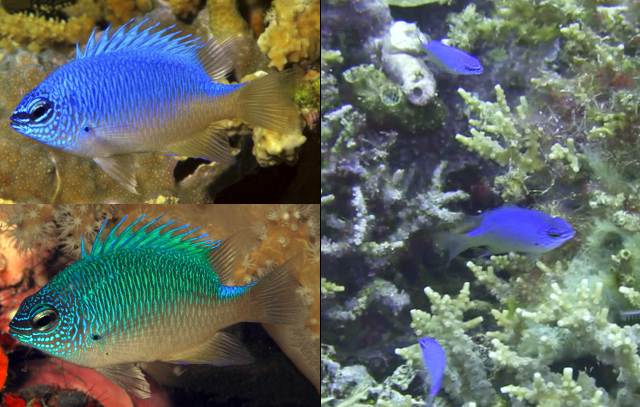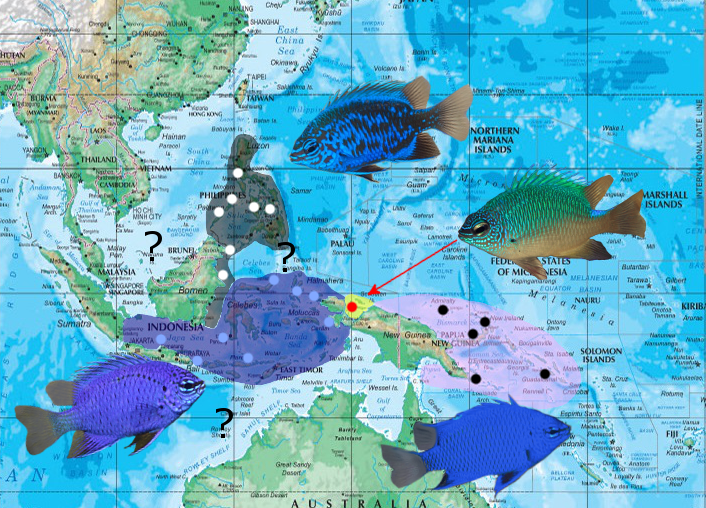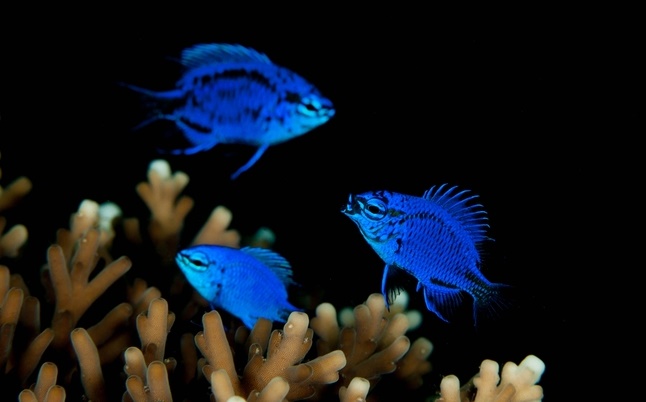
Indonesian C. springeri. A) Bali, Credit: delpacifico B) Raja Ampats, Credit: David Rolla c) Togean Islands Credit: Massimo Boyer D) Lembeh Credit: risingmoon
“Springer’s Damselfish” C. springeri
- Range: Indonesia, though likely absent from the Java Sea and Sumatra.
- Etymology: After ichthyologist Dr. Victor Springer of the Smithsonian
- Size: 5cm
- Aquarium Rarity: Common
- ID: Mostly blue, with little black exposed.
Notes: Very similar to the Melanesian cyamatilis, but without a black spot beneath the soft dorsal fin. While frequently available in the aquarium trade, it seems to be less common than the undescribed species found in the Philippines. It is alleged to feed on Convulotriloba flatworms in aquariums, though not every aquarist reports success with this.
“Black Sapphire Damselfish” C. cf springeri
- Range: Mostly Philippines and Northern Borneo
- Etymology: n/a
- Size: 5cm
- Aquarium Rarity: Common
- ID: Mostly blue, but with large patches of underlying black exposed.
Notes: The northern variant of springeri has long been suspected of being a separate species, and is currently being investigated by Dr. Gerry Allen. Juveniles appear identical to the true springeri, but specimens develops black patches dorsally and on the caudal peduncle as they mature. The ventral fins also turn black, similar to the Melanesian cymatilis. Both springeri and cf springeri may be present in Lembeh, but genetic study is needed to confirm this. In the aquarium, it has been reported that the two phenotypes segregate themselves. I’ve chosen to create a new common name for this species, as there doesn’t seem to be any consistently used name for this population.

C. pricei, from Cenderawasih. Note the greenish hue of the lower left specimen and its sharply contrasting caudal peduncle spot. Credit: Gerry Allen and unknown.
“Price’s Damselfish” C. pricei
- Range: Endemic to Cenderawasih Bay
- Etymology: After David Price, an ichthyologist from New Guinea
- Size: 5cm
- Aquarium Rarity: Absent
- ID: Pattern is similar to hemicyanea or juvenile oxycephala, but the yellow is more pale and diffusely blended with the blue. The small black spot at the base of the pectoral fin is diagnostic.
Note: Depending on lighting, specimens can appear green-blue with only the upper caudal peduncle exhibiting a bright blue. It’s possible populations may exist to the west in the Raja Ampats, as other Cenderawasih endemics have been found here, but it is unlikely that this species will ever be collected for aquarists.
“Blue Sapphire Damselfish” C. cymatilis
- Range: New Guinea (Bismarck Archipelago & Milne Bay) and Solomon Islands
- Etymology: Latin “sea-colored or blue”
- Size: 5.5cm
- Aquarium Rarity: Rare
- ID: Very similar to the Indonesian springeri, but a small black spot is present near the dorsal fin rays.
Notes: The dorsal fin spine count is modally 13 (versus 12 in springeri). A variant from the Ninigo and Hermit Islands of the Bismarck Archipelago has orange throughout the rays of the pelvic and anal fins, but other regions have this colored black. Specimens from the Solomon Islands have been available in the aquarium trade on occasion, though it seems they have seldom been correctly identified.













0 Comments